Inside Hamas’s underground city: Footage shows how the terrorists excavate tunnels, use them to move weapons, carry out attacks on Israel and smuggle prisoners back to Gaza
Chilling images have emerged showing the extensive tunnel systems that Hamas terrorists have used to move weapons and hostages and carry out attacks on Israel.
The images provide insight into the claustrophobic conditions in which the Palestinian Islamist fighters operated.
It shows militants using metal rods and shovels to dig the tunnels. Many of them look quite cramped and dark, with footage showing the fighters moving somewhat slouchedly through the tunnels, guided by headlamps.
Despite the limited circumstances, most tunnels are provided with concrete reinforcement.
The militants are dressed in full military gear, with some hiding their faces with headscarves, balaclavas or wearing camouflage paint. They were heavily armed and carried large machine guns, ammunition and rocket weapons.
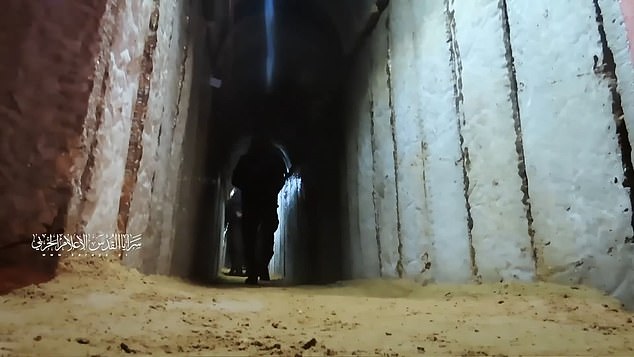
Hamas terrorists have used weapons and hostages to carry out attacks on Israel
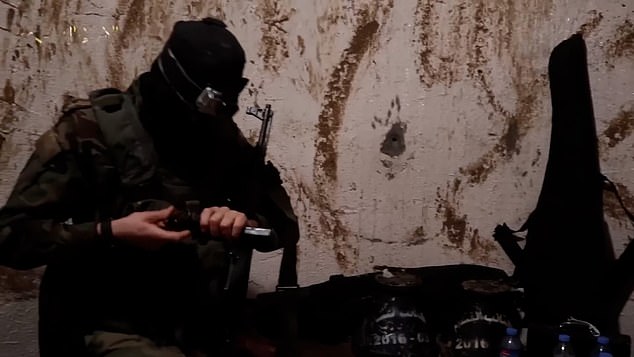
The militants are dressed in full military gear, with some hiding their faces with headscarves, balaclavas or wearing camouflage paint. They were heavily armed and carried large machine guns, ammunition and rocket weapons
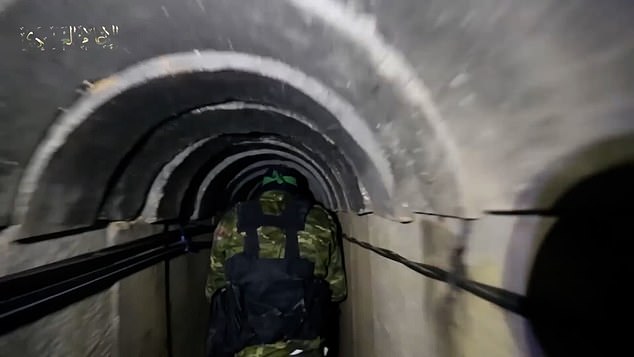
Chilling images have emerged showing the extensive tunnel systems that Hamas terrorists have used to move weapons and hostages and stage attacks on Israel.
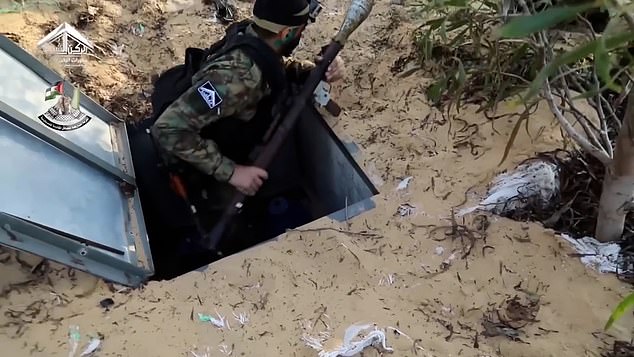
You can see the armed terrorists emerging from hatches hidden by sand, bushes or makeshift barriers
You can see the armed terrorists emerging from hatches hidden by sand, bushes or makeshift barriers. Others carrying missiles can be seen in defensive positions littered with cinder blocks.
Other shots of the tunnels show more extensive and well-lit areas with what appears to be wiring for electricity and communications and Hamas flags and insignia decorating the walls.
They also show off an array of ammunition, with grenades, landmines and large rockets visible.
Their complex network of fortified tunnels, some of which lie up to 40 feet underground and all of which could conceal an ambush, can be booby-trapped or filled with explosives, causing them to collapse.
This means Israel can bomb Gaza as much as it wants and launch bunker-busting munitions to clear some tunnels – but the Israeli Defense Force (IDF) would still have to deploy hundreds of thousands of troops to neutralize every last Hamas fighter if it wants to join the fight destroy. the organization completely out of the closet.
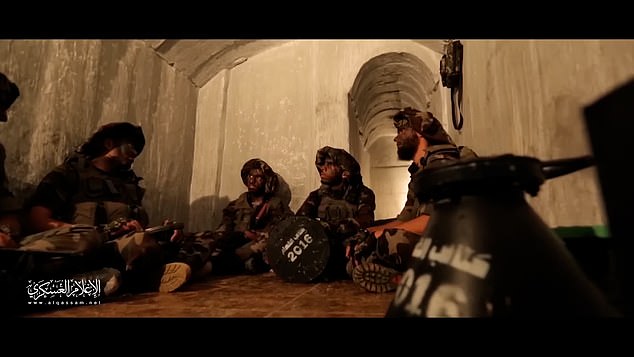
Other shots of the tunnels show more extensive and well-lit areas with what appears to be wiring for electricity and communications and Hamas flags and insignia decorating the walls.
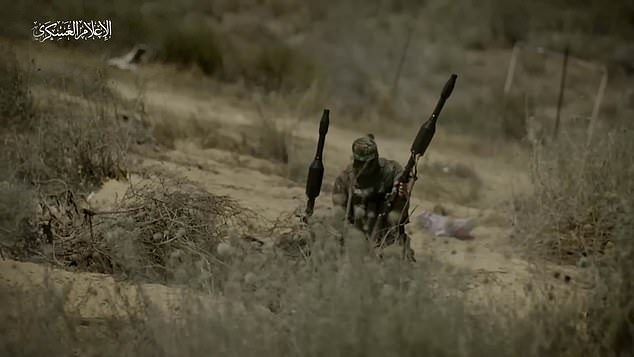
The terrorists can be seen carrying an array of ammunition with grenades, landmines and large rockets visible
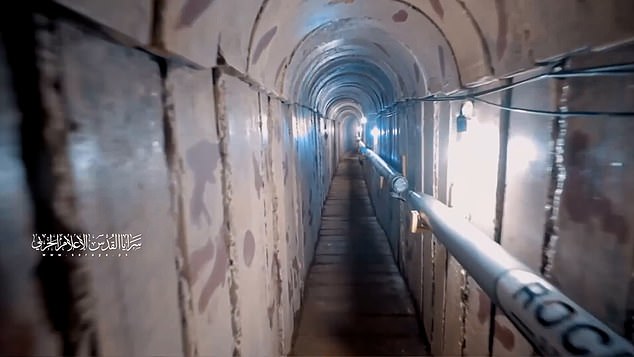
The images provide insight into the claustrophobic conditions in which the Palestinian Islamist fighters operated
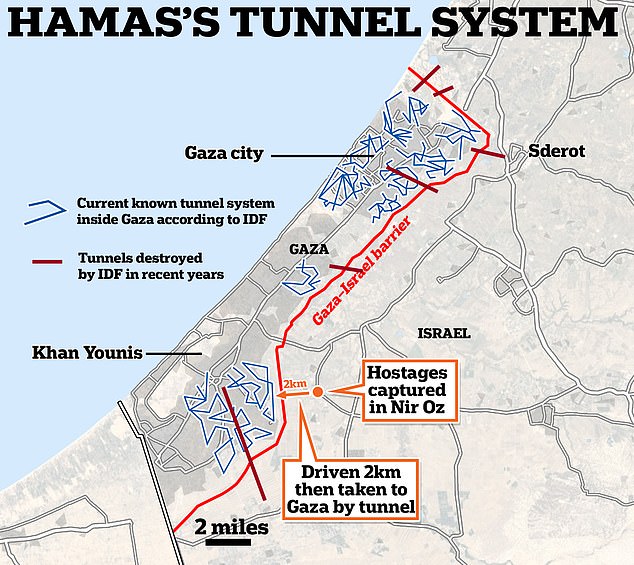
Hamas militants have a complex network of fortified tunnels, some buried up to 40 feet underground, all of which can hide an ambush, be booby-trapped or filled with explosives so they can collapse.
Hamas said in 2011 that it had built more than 500 kilometers of tunnel systems and while analysts suspected this figure was exaggerated, it is certain that the group has expanded the network dramatically since then.
The IDF has long tried – and failed – to destroy the vast network of tunnels built after Hamas took control of the Gaza Strip in 2007.
Not only do they operate underground throughout Gaza, but some of them extend into Israeli territory and have long served as the launching point for many of Hamas’s attacks.
Tunnels were among Hamas’s most effective tools during the 2014 war with Israel, with militants using them to move weapons, enter the Jewish state, ambush IDF soldiers and sometimes even use the underground corridors to enter Gaza to return.
The first Hamas tunnels were built in 2007 between the Gaza Strip and Egypt and were intended for smuggling consumer goods to circumvent the Israeli blockade.
However, some rudimentary networks existed in Gaza as early as 2002. One was used to bomb an Israeli outpost in the Strip in 2004. In December 2004, a second tunnel bomb attack on an Israeli outpost took place, killing five IDF soldiers.
Israel has long struggled to eradicate the system, despite high-quality military and intelligence equipment.
This is mainly because the tunnels, which are believed to have cost between $30 million (£21.3 million) and $90 million (£63.9 million) to build, are extremely difficult to detect from the air.
Some of the three dozen tunnels built since the end of the Israel-Gaza conflict in 2014 have cost an estimated $3 million.
By 2013, the network had permanently turned away from the Egyptian border towards Israel and there were at least three tunnels under the Israel-Gaza border, two of which were packed with explosives.
The underground network now branches hundreds of kilometers through the Gaza Strip, reaching the cities of Khan Younis, Jabalia and the Shati refugee camp. They also extend into Israel.
The tunnels are used by Hamas and other Islamist groups in Gaza, including the Islamic Jihad movement in Palestine, all of whom say tunnels are needed for defense and to circumvent the difficulties imposed by Israel’s strict border controls.
More than 7,000 people have reportedly been killed since the war in Gaza began.
So far, the total of 7,028 deaths includes 2,913 children, the Hamas-led Health Ministry said.
Yesterday the ministry reported 6,546 deaths, including 2,704 children.
Joe Biden said he had “no confidence in the numbers the Palestinians are using,” although he did not explain why.
The Council on American-Islamic Relations said it was “deeply troubled” by his comments and called on the president to apologize.
“Journalists have confirmed the high number of casualties and numerous videos emerging daily from Gaza show mutilated bodies of Palestinian women and children,” said Executive Director Nihad Awad.
